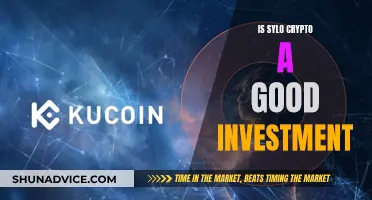
Investing in cryptocurrencies is a risky business, and with thousands of options to choose from, it can be hard to know where to put your money. 'Shitcoins' are essentially cryptocurrencies with little to no value that are often considered bad investments. However, if you invest right, there is serious money to be made.
One way to spot a shitcoin is to look at the number of holders. A healthy new coin should have at least 200-300 holders, and 5-10 transactions per minute. It should also have a liquidity pool of at least $30,000. Another tell-tale sign is if the developers are mysterious – the people behind a project should be trustworthy and happy to identify themselves publicly.
If you're thinking about investing in shitcoins, it's important to remember that the cryptocurrency market is extremely volatile. Many people have lost money by investing in shitcoins, so make sure you only invest what you can afford to lose.
| Characteristics | Values |
|---|---|
| No real-world application | |
| Anonymous development team | |
| Low market value and market cap | |
| Low market liquidity and trading volumes | |
| Undefined roadmap for the delivery | |
| Demand for the token on questionable exchanges | |
| Lack of long-term potential, development vision and loses value over time | |
| Doubtful functionality | |
| Obtrusive promises | |
| Lack of holders | |
| Scarce liquidity |
What You'll Learn

Understand the risks of shitcoins
Shitcoins are a risky investment. The term refers to cryptocurrencies with little to no value that have no immediate or discernible purpose. They are often considered bad investments because their prices are based on speculation. As of January 2021, there were over 4,000 cryptocurrencies on the market, and not all can be successful. Many shitcoins are created to capitalize on people jumping on the crypto bandwagon without doing their research.
Plenty of people have lost money investing in shitcoins, from hundreds to thousands of dollars. The risks of investing in crypto are similar to those of investing in the stock market. It is important to remember that you should never invest more than you can afford to lose and always do your research first.
- Anonymous or mysterious developers: The people behind a project should be trustworthy and identifiable. If the developers are using fake names or remain anonymous, it is a red flag. It is much less likely to be a scam if the developers have identified themselves publicly via video on social media platforms such as Instagram or YouTube.
- Lack of defined functionalities or roadmap: Shitcoins often have big promises but lack defined functionalities or a clear roadmap. Anyone can come up with impressive-sounding goals, but a legitimate project should be able to provide a detailed plan on how those objectives will be accomplished.
- Generic or copied aspects: If a project's website looks generic or uses a free domain, it may signal a lack of authenticity. Additionally, if the white paper is indistinguishable from other popular projects or filled with technical jargon that is hard to understand, it is likely a shitcoin.
- Low number of holders and transactions: Experts recommend that a new coin should have a minimum of 200 to 300 holders. A healthy new coin should also have a minimum of five to ten transactions per minute.
- Low liquidity pool: The liquidity pool is considered the backbone of most decentralized exchanges. If the project you are investing in doesn't have at least $30,000 in its liquidity pool, it is likely a shitcoin. Low numbers, such as a few hundred or a few thousand dollars, should be a warning sign.
While there is the potential for high rewards when investing in shitcoins, it is crucial to be aware of the risks involved. Due diligence and thorough research are essential before making any investment decisions.
Bitcoin vs Gold: Which is the Better Investment?
You may want to see also

Identify signs of a shitcoin
Shitcoins are cryptocurrencies with little to no value or no immediate, discernible purpose. They are typically characterised by short-term price increases followed by sharp declines. These price movements are often caused by investors who want to capitalise on short-term gains.
- Developers are anonymous or not well-known.
- No real-world use case or discernible purpose.
- The name of the coin: if it contains references to animals, memes, or jokes, it is likely a shitcoin. For example, anything with "DOGE", "SHIBE", "DOG", "ELON", or "SAFE" in the title.
- The website and whitepaper: if they "guarantee returns" or make other unrealistic promises, it is likely a shitcoin. Also, check if the whitepaper is trying to solve a real problem or if it's just a collection of fancy jargon.
- Supply: if the supply is unlimited or very high, the coin will likely never gain value.
- Blacklisted words: "Shiba", "safe", "elon", "moon", "mars", etc.
- Promises of high returns in a short period.
- No liquidity.
- Lack of community adoption: if the community doesn't believe in the coin, it is unlikely to succeed.
- Listed on a DX sale.
- Safemoon/Hoge fork with transaction fees for redistribution and liquidity.
- High volatility: shitcoins often experience rapid price increases and crashes.
- Poor fundamentals: the coin may have a poorly designed website, a small community, or a lack of development activity.
- Lack of regulatory compliance: shitcoins may not comply with regulatory requirements, which can lead to legal issues.
- Scam coins: some shitcoins may be outright scams, with no intention of providing any value to investors.
Silver Coin Investment: A Beginner's Guide to Getting Started
You may want to see also

Research well-known shitcoins
Shitcoins are cryptocurrencies that have little to no value and serve no immediate purpose. They are often the result of people looking to exploit less experienced investors in the crypto space. While most cryptocurrencies serve a purpose associated with a blockchain or decentralised application, shitcoins do not.
Shitcoins are usually characterised by a pump and dump process, where the price spikes due to investors jumping in, followed by a sharp fall as those same investors sell their coins to profit from short-term gains. They also tend to have low market capitalisations, which makes it easy for a small number of investors to manipulate prices.
Some well-known shitcoins include:
- Dogecoin (DOGE) – a meme-based cryptocurrency based on a comical picture of a Shiba Inu dog.
- BitTorrent (BTT) – a token built around the file-sharing platform BitTorrent, which already functioned without a token.
- Dent (DENT) – a cryptocurrency used to purchase mobile phone packages, but many believe the application doesn't require blockchain technology and actually functions better without it.
- TRON (TRX) – developed to power the Tron blockchain, but its whitepaper appears to be plagiarised.
- Shibu Inu (SHIB) – a token named after the Shiba Inu dog breed with no purpose and no association with any blockchain or decentralised application.
When researching well-known shitcoins, it's important to look out for red flags. These include:
- Lack of a well-defined function – shitcoins often don't have a clear purpose, unlike Bitcoin or Ethereum, which have specific use cases.
- Poorly written or absent whitepaper – a whitepaper is a crucial resource for any cryptocurrency project. If it's missing, or full of typos and low-quality English, it could be a shitcoin.
- Overuse of visuals and lack of technical details in the whitepaper – a good whitepaper should contain technical solutions and an overview of the problems the project aims to solve.
- Red flags in the initial coin offering (ICO) – if an ICO offers a significant discount for early investors, it could be a shitcoin. It may also be a red flag if there is no product, demo, or code available.
- Anonymous or pseudonymous development team – the leadership team behind a cryptocurrency project should be transparent and have a public social media presence.
It's also important to remember that the term "shitcoin" is highly subjective, and any altcoin can be declared a shitcoin by investors. Therefore, it's crucial to do your own research and make informed decisions before investing in any cryptocurrency.
Free Ways to Earn Bitcoin: No Investment Needed
You may want to see also

Learn how shitcoins work
The term "shitcoin" is used to describe a cryptocurrency with little to no intrinsic value or utility. They are often associated with projects that lack credibility, transparency, or a clear use case. Shitcoins are typically created with the intention of making a quick profit, rather than with a genuine mission to improve the cryptocurrency ecosystem or provide a valuable service.
Shitcoins are easy to identify because they follow a specific pattern. When a coin is launched, there may be some initial interest, but its price remains relatively level. However, the price increases exponentially over a short period as investors jump on board. This is followed by a sharp decline as investors dump their coins at critical price points to capitalize on short-term gains. This pattern of price increases and subsequent nosedives is caused by investors seeking to make short-term profits.
Shitcoins can take various forms, including pump-and-dump schemes, ill-conceived altcoins, clone coins, abandoned projects, joke coins, and shady ICOs. For example, Dogecoin (DOGE) and Shiba Inu (SHIB) are well-known meme coins or joke coins that gained a cult following.
Shitcoins are typically created by individuals or groups seeking to capitalize on the cryptocurrency hype. They are often based on existing blockchain platforms, requiring minimal effort and cost to create. Once a shitcoin is launched, it is aggressively promoted using social media, online forums, and other marketing channels to create a sense of FOMO (fear of missing out) among potential investors.
While some investors are attracted to shitcoins due to their short-term profit potential and speculative nature, it is important to understand the high risks associated with these coins. Shitcoins are synonymous with high risk due to their lack of transparency, solid use case, and credibility. They are prone to sudden price crashes, scams, and financial losses. Regulatory authorities are increasingly scrutinizing the cryptocurrency space, and many shitcoins may face legal challenges or bans.
In summary, shitcoins are cryptocurrencies with little to no value or utility, often created to make quick profits. They follow a pattern of rapid price increases and subsequent crashes caused by investors seeking short-term gains. While some investors are drawn to the speculative nature of shitcoins, it is important to approach these coins with caution due to their high-risk nature.
A Beginner's Guide to Investing in Bitcoin
You may want to see also

Know how to avoid buying shitcoins
Shitcoins are a type of cryptocurrency with little to no intrinsic value or utility. They are often associated with high risk in the cryptocurrency market.
- Conduct thorough research on the cryptocurrency before investing. Scrutinize the project's whitepaper, assess the credibility and experience of the team, understand the tokenomics, and ensure there is substantial community support.
- Look for cryptocurrencies with real-world use cases and a transparent development process. Avoid coins with vague or missing information about the development process.
- Use trusted exchanges and wallets. Quality exchanges employ rigorous vetting processes for the cryptocurrencies they list, filtering out dubious offerings. Secure your investments with cryptocurrency wallets that offer robust security features, such as two-factor authentication and multi-signature support.
- Set clear investment goals and limits. Determine the amount of capital you are willing to risk, define your profit-taking strategy, and decide on stop-loss limits to manage potential losses.
- Be cautious of new coins with massive pre-mines or suspicious token distribution models.
- Avoid coins with an anonymous development team. Legitimate projects typically have their developers doxxed, allowing you to verify their identities and social media presence.
- Be wary of coins with obtrusive promises and unrealistic guarantees of profitability.
- Analyze the coin's market liquidity and trading volumes. A healthy coin should have over 10 transactions per minute and more than 300 wallets.
- Evaluate the project's whitepaper and roadmap. Look for a well-structured whitepaper with clear and attainable milestones.
- Participate in crypto forums and discussion channels to gain insights and flag shady investment projects.
- Refer to the Shitcoin Index, such as the SHIT-PERP or Shitcoin Index Perpetual Futures, to identify coins with a low market cap.
Dogecoin Investment: Worthwhile or Risky Venture?
You may want to see also
Frequently asked questions
A shitcoin is a term used to describe a cryptocurrency with little to no value that is usually based on speculation. These coins are often copycats with no clear goals or innovative features, and are therefore considered bad investments.
Many shitcoins are created to capitalize on people who are jumping on the crypto bandwagon without doing their research. As a result, people may lose money by investing in these coins. It is important to only invest what you can afford to lose and to always do your research before investing.
There are several warning signs that can indicate a shitcoin. These include mysterious or anonymous developers, lack of defined functionalities or roadmap, generic branding and website, complicated jargon in the white paper, low number of holders and transactions, and insufficient liquidity pool.
Some examples of shitcoins that have been mentioned in the past include Dentacoin, Paccoin, and XBY. It is also generally advised to be cautious of memecoins, coins with excessive hype, and coins with a large team of advisors.







